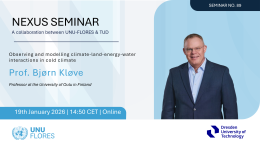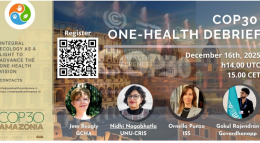Land degradation is occurring at an alarming rate, and at the same time as climate change takes its toll on people and our planet. A report and policy brief by UNU-EHS provide a comprehensive overview of the contributions of land and water management approaches to Sustainable Land Management (SLM) and Land Degradation Neutrality (LDN), which are important concepts in turning the tide on land degradation. While much work is being done towards them, the alignment of approaches with these concepts is not well understood. We sat down with UNU-EHS Research Associate and co-author of the publications, Lisa Hartmann, to discuss what these concepts are and how they can be achieved.
What are Sustainable Land Management and Land Degradation Neutrality?
Sustainable land management is the use of resources, which include soil, water, plants and animals, in a way that ensures they are there for a long time and can be used in the future. In essence, it aims to keep our environmental resources productive and in good condition for future generations. Land Degradation Neutrality is a concept by the United Nations Convention to Combat Desertification (UNCCD), which sets a goal to have no net loss of land from degradation by 2030. While loss of land may occur, those losses are balanced out by land gains. Such a balance is crucial because we must accommodate different land needs, like agricultural production. In terms of how they fit together, approaches to Sustainable Land Management are the means for achieving Land Degradation Neutrality.
How can these be achieved in practice?
The ways to achieve these are through existing natural resource management approaches, for which there are many. Our research is particularly looking at land and water management approaches, such as forest landscape restoration, regenerative agriculture and rewilding. Although there are many, we don't know exactly how they all contribute to SLM and achieve LDN. Furthermore, all these approaches are being used by various stakeholders such as ministries and agencies, private companies, landowners, and more. That is good because every approach has benefits and limitations relevant to a specific context. That does not mean they are necessarily aligned with common objectives or coordinated in terms of targets. To understand how SLM and LDN can be achieved, we need to measure these approaches to gauge where they perform well or where there might be gaps. This is where our assessment comes in.
How did you assess their alignment and what did you find?
First, by compiling existing research we developed pillars for SLM and LDN: ecosystem health, food security, human well-being and cross-cutting. Then, we applied different criteria to each pillar, for instance, under ecosystem health one criterion is “prevents, mitigates, and reverses land degradation.” From there we assessed where our approaches hit the criteria. The idea is by aligning them with SLM and LDN criteria, you can see how an approach like rewilding is ticking the boxes to reach these goals. You then have a bird’s eye view of where they are contributing or not.
We found that even if they come under different names, these approaches all have shared goals and that their benefits may also overlap. For instance, we found a high degree of alignment in the ecosystem health and food security pillars for SLM and LDN. We concluded that a gap remains along the human well-being pillar, as fewer criteria were checked. This could mean a project is not adequately engaging with local stakeholders and communities, indicating a neglect of local needs.
How can policymakers, land management practitioners and other researchers take up your findings?
There are several ways. First, we want them to see how approaches align and with evidence show how they contribute to the criteria of SLM and LDN or not. At the project level, it helps determine what points a project is contributing to these goals and where more work is needed. Second, setting out these criteria and developing these pillars is quite novel and will help future assessments. So, if a ministry wants to assess a land management approach, they could use our framing and criteria. Thirdly, it can help funders determine if a project that uses one of these approaches is hitting the right targets or where to allocate funding for future projects. Wherever possible, projects should bring together approaches to ensure multiple benefits are achieved. Lastly, human well-being must be checked off, because in the end a project that does not might not be supported by people on the ground and be truly sustainable in the long run.




